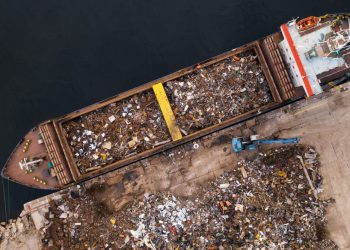Advanced emissions monitoring of large ships calling at EU ports could help save owners and operators of large ships up to €9 million/year, according to a new study published by sustainable transport group T&E. These savings would come from lower operational costs of using automated systems such as fuel flow meters or continuous emissions monitoring, which are already used by many of the world’s largest shipping companies.
Transport & Environment(T&E) has issued a new study entitlted as ” Economic impacts of MRV of fuel and emissions in maritime transport” to estimate the potential fuel saving and therefore lower emissions costs by the MRV implementation.
In June 2013, the European Commission issued a strategy to address GHG emissions from maritime transport. The strategy consists of three consecutive steps:
1. Monitoring, reporting and verification of CO2 emissions from large ships using EU ports.
2. Greenhouse gas reduction targets for the maritime transport sector.
3. Further measures, including MBMs
For the first step, the Commission issued a legislative proposal to establish an EU system for monitoring, reporting and verifying (MRV) of CO2 emissions from large ships using EU ports. Ships would thereby be obliged to monitor four parameters on a voyage basis, namely fuel consumption, distance travelled, time spent at sea, and cargo carried. The monitored parameters would need to be verified and different indicators based on these parameters would have to be reported on an annual basis.
According to the proposed MRV regulation the monitoring methodology for CO2 emissions/fuel consumption would have to be laid down in the monitoring plan with the ships having the choice among the following four alternative methodologies:
1. Bunker Delivery Notes and periodic stocktakes of fuel tanks.
2. Bunker fuel tank monitoring on board.
3. Flow meters for applicable combustion processes.
4. Direct emissions measurements
The European Commission has estimated that the proposed MRV regulation will lead to additional annual administrative costs for the ship owners/operators of about € 76.4 million in total and € 6,700 per entity.
The study finds that if ship owners invested in more accurate fuel consumption monitoring methods they would indeed have to incur higher investment costs but on the other hand their operational MRV costs would decline: the lowest operational MRV costs are associated with direct (continuous) emissions monitoring, followed by the use of fuel flow meters, tank monitoring, and Bunker Delivery Notes combined with stocktakes.
This can be explained by the degree to which monitoring and reporting can be carried out electronically and by the accuracy and verifiability of the monitoring which has an impact on the verification costs. We estimate that ship owners and operators could lower operational MRV costs by € 5 – € 9 million annually by using automated fuel monitoring or continuous emissions monitoring.
In addition, investing in more accurate fuel consumption monitoring will also, due to synergies regarding the EU and IMO air pollution regulations, lead to cost savings for both ship owners and regulators. This holds all the more so from 2015 onwards, when ships in Emission Control Areas will be subject to more stringent sulphur regulations and more inspections will have to be carried out to ensure compliance.
The European Commission expects that the implementation of the MRV regulation will lead to a reduction of the CO2 emissions of European maritime transport of up to 2% in the year 2030. This claim is not substantiated.
Several shipping companies have, on a voluntary basis, started programmes to improve the efficiency of their fleet over the past years. These companies have not only invested in MRV, but also taken various other actions:
- invested in data analysis systems;
- monitored other data;
- taken operational or technical measures to improve fuel efficiency.
It appears that all these actions have to be taken in combination with MRV to be able to achieve efficiency improvements. In most cases, the companies have relied on fuel flow monitoring because it yields more accurate results than periodic stock takings.
The study concludes that only if the MRV regulation prompted ship owners, either on a voluntary or on a mandatory basis, to invest in accurate and comprehensive monitoring and data analysis systems, a significant CO2 emission reduction could be expected from the regulation. This would most likely be a CO2 emission reduction higher than the 2% expected by the European Commission from the currently proposed regulation.
For more details, please read T&E study Economic impacts of MRV of fuel and emissions in maritime transport






























































